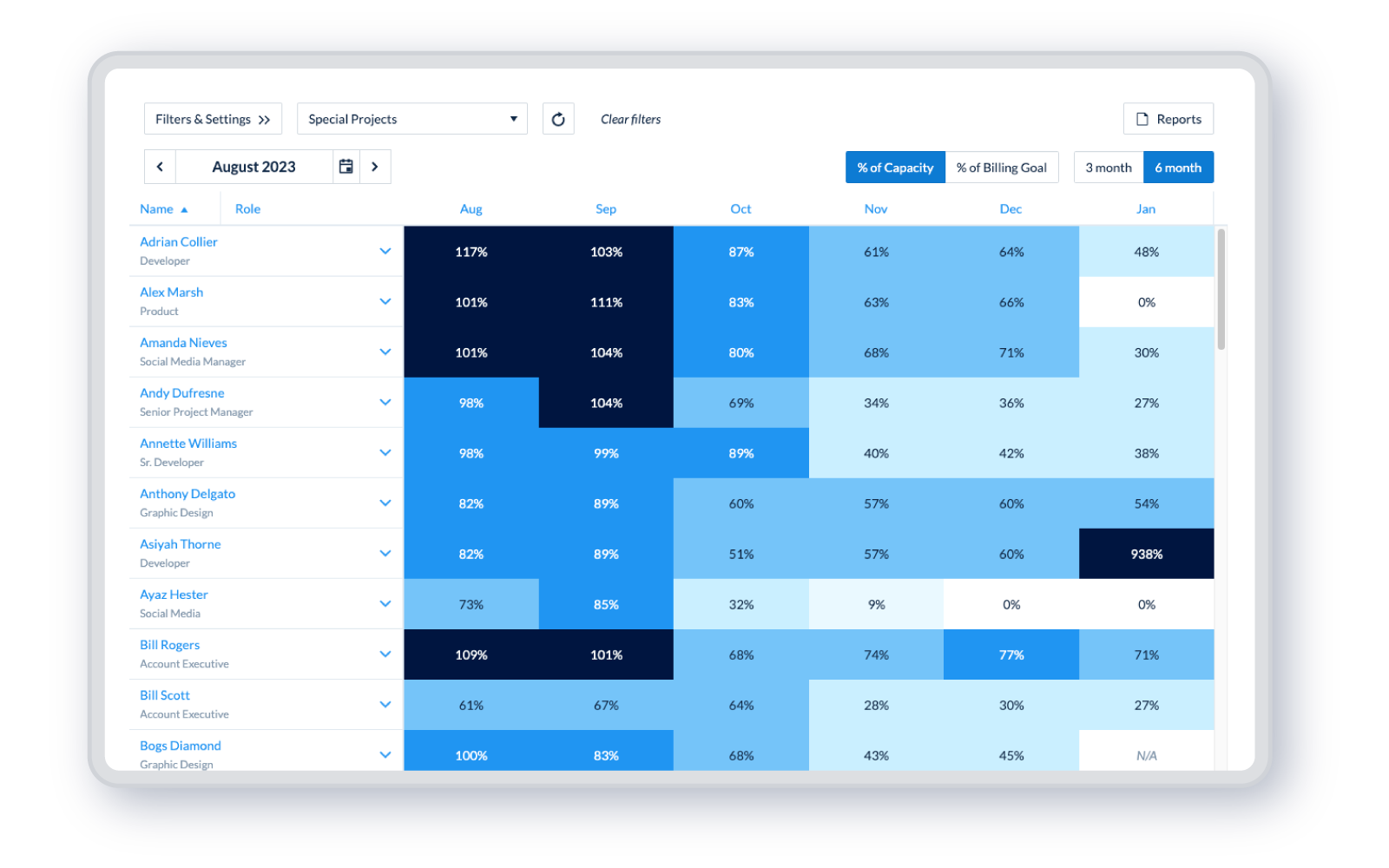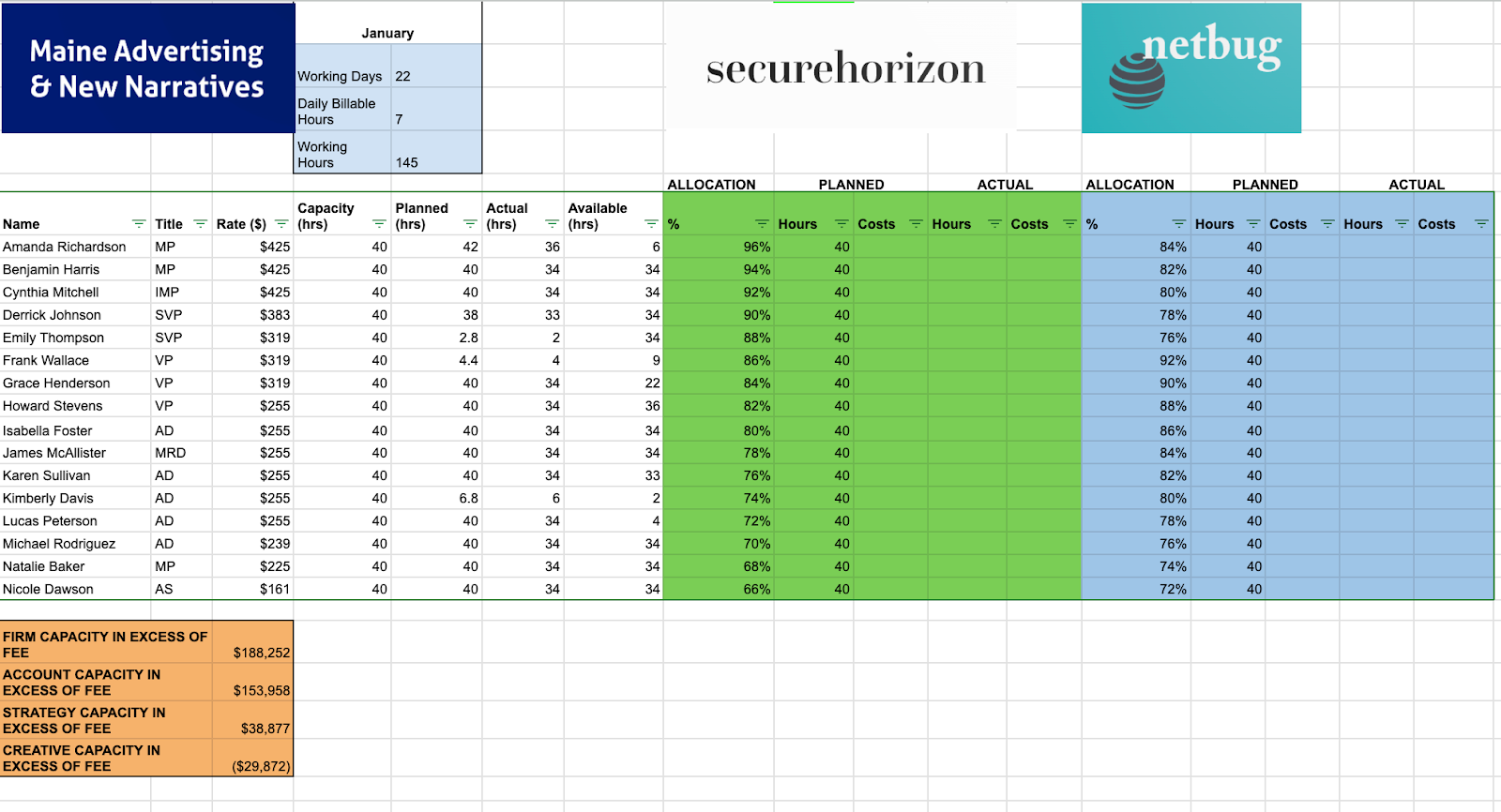You’re Doing Capacity Planning Wrong
Table of Contents
Capacity planning requires time, effort, and dedication. Without the right tools, it’s an uphill battle.
What is capacity planning?
If you won a new client next month, do you have enough staff to service them? How about staff capacity over the next 6 months? When was the last time you knew exactly how much work you needed to keep utilization healthy next quarter?
We’re talking about capacity planning: the ability to make accurate predictions about staff utilization, project volume, budgets, and profitability based on reliable historical data.
At ClickTime, we’ve learned a lot by watching finance and operations managers navigate these questions. The surprising discovery we’ve made is that most professional services firms have poor visibility on their future finanical health and waste opportunities, which cost them valuable margins.
What are most firms doing?
Well, it usually looks something like this:
We typically see firms allocating staff to clients and projects in advance somehow, but it usually involves a fragile spreadsheet, a lot of manual inputs, and hours or days every month.
Some firms have a system that’s supposed to predict capacity demands. Turns out, the system is a glorified spreadsheet relying on manual inputs and individual analysis. Even with a “solution in place,” it’s still up to project managers to predict capacity, and therefore, profitability, in what may become a painstaking, weekend-long event.
Managers or project planners shouldn’t have to spend time this way. Not when the problem’s already been solved. But before we get to the solution, let’s make a few observations about the qualities of good capacity planning.
What does good capacity planning look like?
- It lets you see into the future: Avoid surprises by knowing what’s ahead. Bottlenecks in delivery and or more projects than your team can handle will throw the organization into a tailspin. And they’ll chip away at reputation among clients.
- It empowers your managers: The spreadsheet approach is fragile. Who gets access? What about version control? How can a manager course correct mid-way through the month? What if someone suddenly leaves? Is the source data vetted? The point is, your spreadsheet is either a huge administrative burden to project managers or irrelevant to team managers. Proper capacity planning is dynamic. It therefore empowers project managers to make quick decisions and team managers to move in accordance.
- Your team will be properly utilized: Capacity planning provides flexibility. You’ve hired specialists on purpose. If you’re overbooked as a firm, you lose the freedom to put that talent to work where it’s most effective.
- Deliver on-time and on-budget: Without a plan, you leave success to fate. The individual efforts of your engineers, creatives, etc. can create great customer deliverables – but they can’t deliver great operating results without a process to forecast and monitor progress.
Ultimately, excellence in each of these areas contributes to maintenance of margins, which builds firm profitability. When the firm is profitable, everyone benefits.
How to do capacity planning right
At ClickTime, we’ve spent years working with firms trying to do the exact same thing. Every professional services firm, whether it is a creative agency, consulting firm, or research organization, wants to deliver great client service and excellent work while remaining profitable. Firms of every size have shared with us how they are trying to plan for great delivery two, three, or six months in advance…and we believe we’ve come up with a pretty good solution.
Our criteria for an acceptable solution to the unacceptable number of hours project managers devote to staff allocations is:
- Automated staff capacity map based on both hours and budgets,
- Built on trustworthy, verified data
- Available at a moment’s notice without manual updates required
With the right capacity planning tools in place, we’ve seen organizations boost profitability by by 50%, 75%, or even double.

ClickTime’s capacity planning heatmap allows firms to view their employee’s billable and total capacity six months in advance.
What difference does it make?
Planning for your firm’s capacity fuels profitable decisions and will likely increase revenue in the short term. The right technology will prevent capacity planning from becoming a burdensome activity. It will ensure the time spent up front is worthwhile.
At ClickTime, we worked with a technical services provider for the life sciences industry called VEQTOR. Staff allocations was a drawn-out, siloed process for the project managers at VEQTOR, often requiring several different meetings every month. After implementing ClickTime to centralize resourcing, the project managers found they were able to take on more projects and drive revenue. In their own words, “We are planning for success rather than firefighting.” Learn more about VEQTOR’s transformation here.
Speak with a ClickTime Expert
Get a free demo of our easy timesheets, powerful reports, and world-class support.







